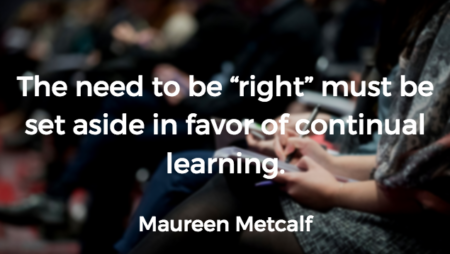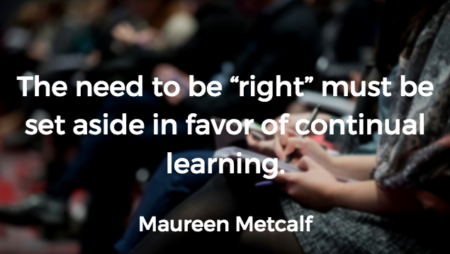How to Create a Culture of Innovation and Learning

This post is from a Forbes article I wrote in 2017. It is the companion to a Voice America interview with Guru Vasudeva, CIO Nationwide Insurance on VoiceAmerica “Innovative Leaders Driving Thriving Organizations” on April 18, 2017 Nationwide’s Journey to Build a Culture of Innovation and Continuous Learning.
When it comes to innovation, companies need to deliver results much more quickly than they did just a few years ago in order to keep pace with the range of pressures they face from competition as well as customer expectations. In addition to the range of product change and customer expectations, companies are looking at a baby boomer retirement rate of 10,000 per day, which is only accelerating technological change and a volatile geopolitical environment.
With this as the backdrop, leaders must create organizational environments that weave innovation and change into their fabric.
There are several different terms we hear when we talk about companies that do this well: agile businesses, “learning” organizations, and innovative cultures are just a few. These environments adhere to five key cultural and structural strategies.
1. Delight Customers
Organizations should seek out customer recommendations and develop a process to evaluate and prioritize ones that have the highest probability of meeting customer objectives and staying ahead of the competition.
This recommendation is drawn from my early work with Malcolm Baldrige Quality Assessments. Though this has been an enduring practice for years, how companies implement it has changed. How are you seeking ongoing feedback on priorities and customer satisfaction first and foremost? Are you creating a relationship with customers that could be most accurately described as a partnership? Have an open exchange with clients on a regular basis. In addition, solicit formal feedback on a periodic basis.
2. Actively Collaborate
Organizations must shift from step-by-step processing to working cross-functionally. All involved departments should remain informed and work simultaneously as a normal course of business. Collaborative organizations create higher-quality prototypes — and they do it more quickly.
In addition to a collaborative structure, it’s important to create an environment where every team member feels safe and encouraged to contribute. They should also feel that they are expected to contribute their best work at all times. This collaboration contrasts with organizations where “special people” contribute more often than others.
My client structures projects to ensure all team members or subject matter experts are included. The teams also conduct vibrancy assessments to ensure they are continually creating an environment where everyone feels included and supported. What are you doing to measure your culture and agreements to ensure all members participate and feel safe to share their insights?
3. Rigorously Experiment
Teams must study problems and put forward well-developed solutions. However, these shouldn’t come in the form of long studies, as many of these can take a year or longer.
By shifting to a focus on the scientific method, teams learn to formulate a hypothesis, test that hypothesis, and learn and refine solutions rapidly.
Note the word “rigorous.” I realize that the idea of experimentation is very countercultural, and if done poorly, can be costly. When teams develop skills in rigorous experimentation, they shift how they look at experiments. One example is a group that structured the work using rapid prototyping. They provided mentors and coaches to ensure people had the support they required while learning the new process.
This mentoring ensures team members contribute quickly and develop both skills and comfort with new behaviors quickly. Do you have challenges and opportunities that could be solved more quickly by taking a more scientific approach, perhaps by shortening the analysis and beginning experimentation?
4. Accelerate Decisions And Learning
In this environment, nimble decision-making is a companion to rigorous experimentation. Team members must make the best decisions possible as quickly as required. These decisions must be open to re-examination as new information surfaces.
This means that decisions should be refined on an ongoing basis. The need to be “right” must be set aside in favor of continual learning. What was once called “flip flopping” will now be called “learning.”
An example of nimble decision-making is an organization that offers training to help participants combine data-based decision-making with intuitive decision making to leverage the power of both. They make decisions at the appropriate point to support the process of experimentation. When experiments are run, participants learn, and prior decisions will be revisited when appropriate and updated.
5. Build Adaptability And Resilience
Leaders and their employees must value adaptability, flexibility, and curiosity. All of these skills and aptitudes support an individual’s ability to navigate rapid change. Employees must remain flexible and focused in the face of ongoing change. They need the capacity to feel comfortable and supported by their colleagues so that they can adapt to planned and unplanned change with creativity and focus.
It is not enough to tell people to be more resilient, then expect them to answer emails for 20 hours a week. I once worked with an organization that conducted training on individual resilience, then had work groups conduct multiple discussions about what they needed to do to support individual resilience.
Does your organization make explicit agreements about topics like expected response time for email, including during non-work hours? Agreements are a great way to examine organizational factors driving and inhibiting resilience.
Evolving your organization to become more innovative and change-friendly requires a structured effort to update your culture and the systems and agreements that support its functions. By clarifying how your organization promotes these five elements, you will make great progress in becoming an innovative organization.
To become a more innovative leader, please consider our online leader development program. For additional tools, we recommend taking leadership assessments, using the Innovative Leadership Fieldbook and Innovative Leaders Guide to Transforming Organizations, and adding coaching to our online innovative leadership program. We also offer several workshops to help you build these skills.





